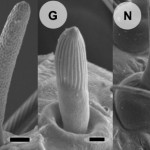Let’s try something new. I predicted that my story on a ‘Measles Outbreak Traced to a Fully Vaccinated Patient for First Time’ would generate a cloud of comments on Facebook (Science Magazine + ScienceNOW). Like a storm offshore, I saw it coming. So I posed extra questions to my sources that could cover the eventual deluge.
So here is a true-or-false pop quiz on measles based on reader comments and answered by the extra reporting that couldn’t fit into a 600-word story.
One note before we begin: this isn’t an attempt to crucify or lambaste critics, but rather an opportunity to answer questions—something that I enjoy doing as a reporter. I should also mention that this was originally posted to Outfog.com.
OK, are you ready to begin? Pencils up. Let’s start with the basics…
Statement: This is nothing new or unexpected.
The crucial detail in this study is transmission. Measles does occur in the ‘fully vaccinated’—herein defined as receiving two childhood doses of the vaccine—but no one had ever observed subsequent transmission from such a person:
Measles may occur among vaccinated individuals, but secondary transmission from such individuals has not been documented. – Rosen et al. 2014.
Hence why ‘Measles Mary’ was released without hospitalization. A quick scan of New York State policy on measles control from 2012 (flip to pgs. 9-11) suggests that anyone with a two-dose measles vaccine history “may be immediately readmitted” to school or work.
Had measles transmission from a two-dose vaccinated person happened before? Probably, though it is likely rare. This case report provides a profile for what future instances may look like, in terms of antibody response, which is valuable for disease control.
Jennifer Rosen is an epidemiologist at the NYC Bureau of Immunization and the study’s lead investigator. I asked her how this index case from 2011 factors into the management and surveillance of NYC’s current measles outbreak?
As a result of our experience in 2011, we pursue the same control measures following exposures to cases of measles, regardless of the case’s prior vaccination status and continue to monitor for evidence of secondary transmission from previously vaccinated cases. – Jennifer Rosen.
This case report fills a crucial gap in the collective understanding of measles herd immunity. It revised a public health strategy and is now potentially reducing the spread of disease. Science wins! But speaking of herd immunity…
Statement: No scientifically literate person thinks that vaccines give you 100% immunity.
Hence why I wrote: “Less than 1% of people who get both shots will contract the potentially lethal skin and respiratory infection.”
These comments hearken back to an excellent remark made by Robert Jacobson, director of clinical studies for the Mayo Clinic’s Vaccine Research Group.
“There is a fiction that immunity is an on-off -, binary-, or an existential phenomenon, when we know biologically that is most likely a continuum. People don’t like to think of some being more immune than others. We like to think that the vaccine worked or didn’t work. We like to think that you’re immune or not immune. This carefully done case report really demonstrates that in reality we’re dealing with a continuum.” – Robert Jacobson
In our interview, Jacobson also answered and echoed Mr. Sumner’s comments, “We cannot substitute a history of being vaccinated as proof enough for immunity, as this case illustrates.”
The measles vaccine does a superb, almost Herculean job of protecting the continuum. Yes, some won’t respond to immunization, but the vaccine failure rate after a single dose hovers around 5%. A booster shot lowers this figure to less than 1%.
In other words, the measles vaccine kicks ass. In the year 2000, measles killed 560,000 people worldwide. Global vaccination programs dropped this death toll to 122,000 by 2012—a 78% reduction. One tiny shot saves millions of people. People who get to watch sunrises, hug their moms, slap high-fives, have sex, walk, eat, breathe—people who get to live.
Statement: It’s called evolution and mutation for a reason…
I spoke with William Moss, a pediatric infectious disease specialist at Johns Hopkins University, who co-authored an excellent Lancet review on the measles that everyone should read.
Here is what Dr. Moss told me:
The current [attenuated] vaccine used in the U.S., and throughout much of the world, is all derived from a wildtype measles strain that was isolated by John Enders in the mid-1950s. This vaccine is based on a virus strain that’s been around for decades. There is no evidence over this time that the virus has mutated significantly enough to interfere with the efficacy of the vaccine.
Herd immunity worked for smallpox, which had a low mutation rate. The mutation rate for measles is slightly higher, but the virus hasn’t figured out how to render the vaccine ineffective. If other countries could implement the measles vaccine akin to how the world united with smallpox, then we’d have a fighting chance for eradication.
What happened to ‘Measles Mary’ isn’t about a failing vaccine or a mutating virus, but the fabric of our immunity. The case report raises valid questions about its integrity.
Why did ‘Mary’ show signs of both a primary and secondary, albeit weakened, immune response? Does measles immunity wane over time? Both Jacobson and Moss described this report as one that advances the public understanding of secondary vaccine failure for measles.
This is especially poignant when the science-minded say things like…
Statement: All vaccines have an extremely low failure rate.
As Robert Jacobson highlights:
“For many vaccines, waning actually plays a major role. One doesn’t need to look any further than mumps. With mumps, we have been able to measure substantial waning, and it does pose a problem. Unlike measles, the vaccine doesn’t seem to give a lifelong durability for the most part.”
A news report by André Picard from 2011 emphasizes this reality.
For the anti-vaxxers in the audience, that’s an argument FOR vaccination, not against it. Because as Ms. Mayo states “if the community vaccination rate is high enough they won’t contract or spread the disease.”
But speaking of anti-vaxxers…
Statement: Oh, Jesus Christ! The anti-vaxxers will make today a national holiday.  False (I hope.)
False (I hope.)
The thought did cross my mind before I pitched and wrote this story. Here is why I ultimately decided to pursue it.
Science writing shouldn’t be dictated by people who do not believe in the empirical foundations of the scientific method. Volumes of studies show that the measles vaccine works. Anyone who doesn’t believe the research should just look around. The U.S. averages 60 measles cases per year today versus the 600,000 annual cases recorded during the pre-vaccine era.
The U.S. and other developed nations are entering uncharted territory. Many have forgotten what children look like when they catch the measles and other preventable infections. As William Moss put it:
“What I tell people is successful public health programs undermine themselves. The disease goes away, people lose interest, and they don’t see it as a risk. In this country [the U.S.], people start thinking that the risk of the vaccine is greater than the risk of the disease, and soon the political and financial commitments go away.”
In the U.S., the chains of measles infections that handcuffed a nation to decades of endemics and death were broken. Will we wear those chains again? I hope not, but the decision ultimately rests with all of us.
Header photo: Albert G. | Flickr (CC BY 2.0)












Comments are closed.